What are good pole options for mounting nest boxes?
- You’ve determined the best spots at your project site for boxes, spots where competition from other species and exposure to nest predators should be low.
- This web page presents two pole options for nest boxes and the next web page, Mounting Boxes on Poles, shows how to put your boxes up.
- In our opinion metal poles are the best options for supporting nest boxes, and we’ll present two metal pole systems: steel pipe and conduit/rebar.
- Please note, we don’t recommend wooden poles or snow-fence poles. Wooden poles are easy for predators to climb and can rot. Snow-fence poles are also rather easy to climb and generally too short, allowing predators to jump to boxes.
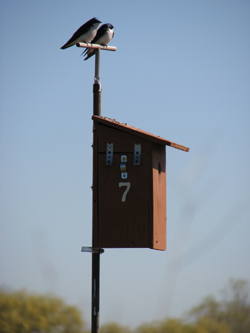
Nest Box Pole Option 1: Steel Pipe.
- We have used steel pipe for many years and are quite satisfied.
- Material needed: 1/2″ interior diameter steel pipe cut to 8-1/2′ lengths.
- Most building supply or hardware stores will cut pipe to size if bought there.
- Galvanized finish or black painted finish are equally okay.
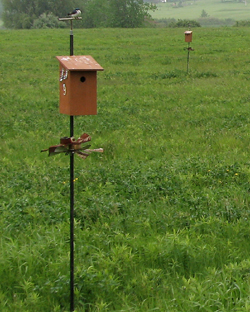
- We dig a hole roughly 2-1/2′ deep, which leaves 6′ of pole above ground.
- Then we backfill with dirt, using rocks to keep the pole from tipping.

Nest Box Pole Option 2: Conduit/Rebar.
- We don’t use this system ourselves (except when we need to get a box up in a hurry to defuse a takeover attempt), but are including it on the recommendation of others.
- Conduit/rebar poles are not as strong as steel pipe, but are cheaper and much easier and convenient to put up and take down.
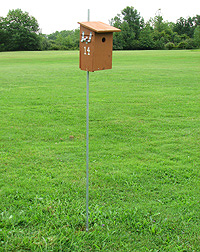
- Materials needed:
- 4′ or 5′ pieces of steel reinforcing bars (rebar) (below left).
- 1/2″ metal electrical conduit tubing (below left) cut to 6′.
- Most conduit is thin-walled and easily cut by hacksaw.
- 1/2″ conduit couplers (below right).
- Attention: One coupler set-screw must be replaced by a longer screw (lower screw in picture).
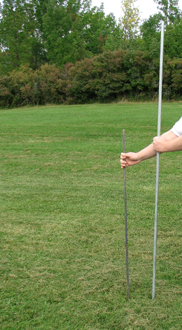

- Drive rebar about half its length into the ground. Hopefully, no digging required.
- If you are lucky, and have deep, rock-free soil, you can use a portable drill with suitably sized auger bit to create the hole.
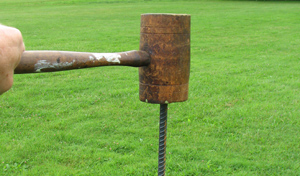
- Attach conduit coupler short screw end firmly to conduit (see below).
- Slip conduit over rebar, coupler end first, until coupler contacts the ground.
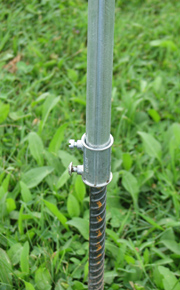
- Use screwdriver to tighten the long coupler screw very firmly onto rebar. This prevents the conduit pole (and nest box) from pivoting around.
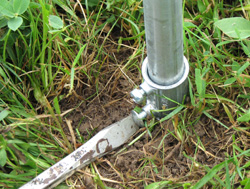
- There is a very nicely-done page on the Nest Builder website illustrating the conduit/rebar pole system and showing how to install it.
In Summary:
- If done right both pole options provide adequate support for nest boxes, but we still prefer steel pipe. After all you never know what extra weight the pole may need to hold.
- Photo below of a young Bald Eagle perched on a Tree Swallow box in Alaska, taken by Tim van Nus.
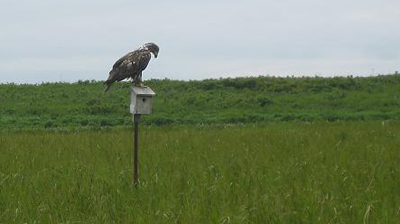
Next Step: Mounting Boxes on Poles
——————————————————————————
Home: Tree Swallow Nest Box Projects
Creating Tree Swallow Nest Box Projects
Spring Return
Nesting Season Behavior
Song and Calls
Nest Site Claiming
Pair Formation
Nest Building
Bird Flight
Mating and Paternity
Diary of One Season at Salmon Creek
Monitoring Nest Boxes and Keeping Records
Making Box Checks Keeping Box Records Control Sheets Season Summaries Print Sheets
Banding Your Tree Swallows Banding Adults Banding Nestlings
Tree Swallows in Research Research Bibliography Glossary of Terms